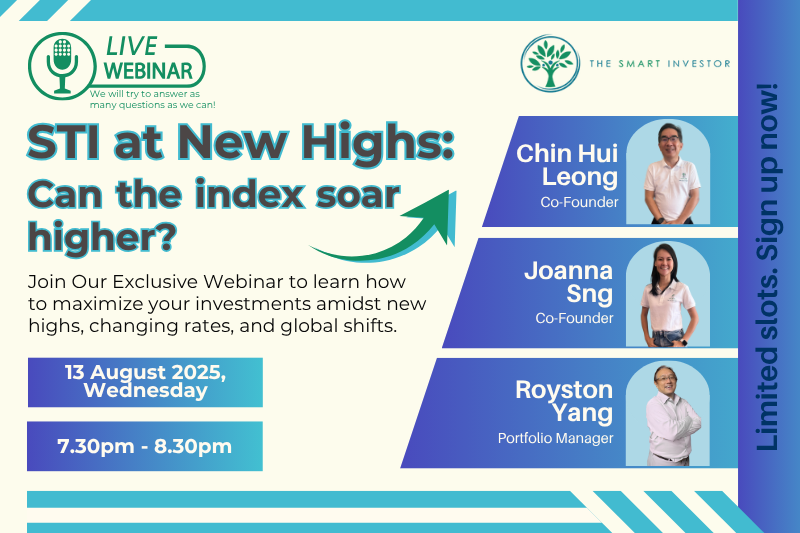Every investor hopes that the shares they buy continue to rise, netting them valuable capital gains.
However, no investor is perfect, not even Warren Buffett.
There will be times when unexpected events crop up or weak sentiment prevails, causing the share price of your investment to fall below what you bought it for.
When this happens, how should you react?
Is it better to cut your losses and move on to a better investment, or continue to hold the shares?
Yet another option may be to scoop up more shares to lower your average purchase price.
Beware of anchoring bias
The first thing you should remember is not to fixate on the price you paid for the shares.
Remember that the shares do not know that you bought them.
This type of bias is known as “anchoring bias”, where your mind tends to peg the value of an investment to the price at which you bought it.
However, as time goes by and the business changes, this purchase price should be irrelevant in terms of whether you should sell the shares, or buy more.
Instead, you should assess the business on its own merits and then decide what to do.
By doing so, you can avoid this emotional bias and make better investment decisions.
Assessing the business
Next, you should assess the business behind the stock to find out how it has performed.
Share prices may plunge because of different reasons such as a poor earnings report, an unexpected macroeconomic event (think: Trump’s tariffs), or weak sentiment towards a particular sector.
Companies may also report unexpected profit warnings or be subject to lawsuits that could negatively impact their prospects.
The key is to determine if the bad news is a temporary event that the business can overcome or if it may be symptomatic of a more structural issue that affects the company.
Companies can recover from temporary events, and it may be a golden opportunity to scoop up shares when they are down.
But if the business faces a structural decline that will affect it months and years down the road, it may be a good idea to part ways with its shares.
Short-term, transient events
A good example of a short-term negative event was the 12% plunge in the shares of iFAST Corporation (SGX: AIY) in late April.
The fintech had lowered its Hong Kong profit guidance for 2025 from HK$500 million to HK$380 million, shocking the market.
However, iFAST reported strong growth in its net profit for the first quarter of 2025, up 31.2% year on year to S$19 million.
The group also saw net inflows of S$938 million that helped to grow its assets under administration to a new high of S$25.68 billion.
Furthermore, iFAST also upped its interim dividend from S$0.013 to S$0.016, and reported a second consecutive quarter of profits for its digital bank division.
In light of these developments, it would seem that iFAST’s share price plunge is only temporary and that the business is still growing.
Possible structural issues
On the flip side, Nvidia (NASDAQ: NVDA) saw its shares fall nearly 7% back in the middle of April when the US government tightened its export rules to China.
The rule concerns its popular H20 artificial intelligence (AI) chip, which is at the heart of the AI boom.
Nvidia faces this restriction because of an escalating trade war between the US and China.
This rule could be here to stay if the US government has its way, and could crimp the GPU manufacturer’s revenue and profits.
The limits placed on Nvidia’s H20 chip may last for the long term, forcing the company to rely on an alternative product to make up for its revenue shortfall.
Investors need to assess if this problem is likely to go away soon, or if it could be here to stay.
Get Smart: An important decision to make
The above examples illustrate how difficult it can be to determine if you should buy, sell, or hold a share even after its share price has plunged.
There are no clear-cut scenarios and a lot of judgement is required for you to assess the situation and come up with a conclusion.
In a nutshell, a temporary problem means you should either hold or could even buy more, as shares will be cheap because of the pessimism.
But if the issue is structural and likely to last for a long time, you could be better off looking for a more promising investment idea.
Many investors think DeepSeek lowering AI costs means less revenue for tech companies. But that’s not the full story, and believing it could cost you. In our latest free report, we unpack a surprising insight from a top tech CEO who explains why lower AI costs may actually drive more tech spending, not less — and he’s got the numbers to prove it. If you’ve misunderstood this trend, you could miss out on some of the biggest investment opportunities. Click here now to access “How GenAI is Reshaping the Stock Market” today to get the full breakdown.
Follow us on Facebook and Telegram for the latest investing news and analyses!
Disclosure: Royston Yang owns shares of iFAST Corporation.






